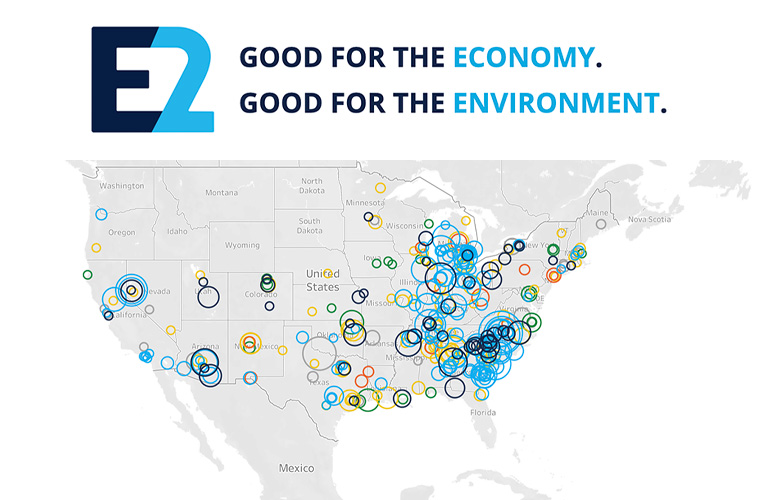COLUMBUS, Ohio — Clean energy and clean vehicle companies added more than 5,000 jobs in Ohio. During the first full year of the federal Inflation Reduction Act (IRA), the total number of clean energy workers in Ohio grew to more than 119,000, according to the ninth annual Clean Jobs Midwest report released today by the national, nonpartisan business group E2 and Evergreen Climate Innovations.
Boosted by the more than 340 major clean energy projects announced across the country since the passage of the IRA, clean energy jobs in the state grew 4.4 percent last year – over 5 times faster than economy wide jobs in Ohio, according to data from the Bureau of Labor Statistics’ Quarterly Census of Employment and Wages (QCEW). The spike in clean energy jobs included 407 new manufacturing jobs and 2,054 jobs in clean vehicles, the fastest growing sector (9.2%) for clean energy jobs in Ohio once again.
Ohio ranked 8 in the U.S. for clean energy jobs. Energy efficiency remains the top overall clean energy employer with over 78,700 workers followed by clean vehicles (24,300 jobs), and renewable energy (11,489 jobs). Most of the state’s clean energy workers are employed in construction and manufacturing.
Columbus, Cleveland, Cincinnati all ranked in the top 10 for Midwest metropolitan areas with the most clean energy jobs, accounting for 55,400 jobs total between them.
“The historic policies and incentives created by the IRA are powering an American economic revolution across our energy industry, and workers and businesses across the Midwest are benefiting,” said Micaela Preskill, Midwest Director of State Advocacy for E2. “This report clearly shows clean energy is driving significant employment gains and outpacing traditional energy sectors, demonstrating the importance of data-driven policy making to create jobs where they are needed most.”
“The rapid growth in clean energy jobs across the region reflects the momentum of innovation to address climate change head on,” said Michelle Carr, CEO of Evergreen Climate Innovations. “Companies are expanding, hiring, and driving technological breakthroughs that are crucial for a sustainable future. At Evergreen Climate Innovations, we witness firsthand how startups in our portfolio respond to the opportunities created by the Inflation Reduction Act, driving growth in the region and positioning the Midwest as a leader in the clean energy transition. This progress begets more progress and we are optimistic for what’s next as innovators transform the energy landscape to be carbon free.”
“Supporting green manufacturing and green energy benefits us all in so many ways: we’re creating jobs, saving money and developing a more sustainable, safer and healthier world not just for ourselves but for our kids and generations to come,” U.S. Senator Tammy Duckworth (D-IL) said. “This report confirms something I’ve been working hard to support in Washington – the expansion of clean energy and the programs that support it are at the heart of job growth in Illinois and throughout the Midwest. The Inflation Reduction Act and the Bipartisan Infrastructure Law are helping move our country forward and today’s report reiterates these policies are working.”
“Throughout my career, I’ve witnessed significant growth in the Midwest clean energy industry,” said CEO of Wisconsin-based Sun Bear Industries Isaiah Ness. “When I was in college, I had friends move from Wisconsin to California to take jobs in solar. Now, you don’t have to leave the Midwest to find those jobs and opportunities. I started my own company 2 years ago with the goal of bringing the benefits of renewable energy to disadvantaged communities. The unequivocal benefits of cheaper, more resilient power combined with federal investments that bring down the cost of renewable energy even more, have made it possible for my company to expand quickly, hire more workers, and develop renewable energy projects throughout the Midwest. The clean energy industry in the Midwest is strong and positioned to grow rapidly over the coming years and I’m excited to be a part of it.”
Nanograf opened a manufacturing facility in Chicago, IL in 2022 and recently announced a new facility opening in Flint, MI.
“At NanoGraf, we’re proud to be creating jobs in our community and providing our employees invaluable experience in cutting-edge clean energy technologies,” said Julia Downing, Ph.D. Senior Technology Development Scientist at Nanograf. “As a 100% U.S.-owned company onshoring the production of advanced silicon anode materials for U.S. military applications, we’re exactly the kind of business the Inflation Reduction Act (IRA) was designed to support. It’s boosted our workforce, investments, and demand for our products in new industries.”
Nationally, U.S. clean energy jobs outpaced overall economy wide job growth by 200 percent, adding almost 150,000 jobs for a total of 3.46 million.
For a copy of the Clean Jobs Midwest 2024 report to dive deeper into the data including subsector data such as solar and electric vehicle jobs and explore jobs down to the state, county, and metro levels, visit https://www.cleanjobsmidwest.com/.
Additional Key Findings:
- There was 3.9 percent growth in clean energy jobs in 2023 in the 12 state Midwest region.
- The Midwest region is now home to 761,051 clean energy jobs.
- There was 9.1 percent growth of jobs in the clean transportation sector in the Midwest, the region’s fastest-growing sector in 2023.
- Small businesses drive Ohio’s clean energy sector – in 2023, 66 percent of Ohio’s clean energy businesses employed fewer than 20 people.
- 11.4 percent of those employed in clean energy are military veterans.
Methodology
This analysis of U.S. clean energy employment is based on employment data collected and analyzed by the BW Research Partnership for the 2024 U.S. Energy and Employment Report (USEER). The USEER analyzes data from the U.S. Bureau of Labor Statistics (BLS) Quarterly Census of Employment and Wages (QCEW) to track employment across many energy production, transmission and distribution subsectors. In addition, the 2023 USEER relies on a unique supplemental survey of 42,000 business representatives across the United States. Created and conducted by BW Research, the methodology has been approved by the Office of Management and Budget (OMB) and U.S. Department of Energy (DOE). This survey is used to identify energy-related employment within key subsectors of the broader industries as classified by the BLS and to assign them into their component energy and energy efficiency sectors.
A full methodology on the sectors and types of jobs this analysis includes and does not include is available in the report, available here.
Other Resources
- Clean Jobs America 2024 State & County Maps: cleanjobsamerica.e2.org/
- Inflation Reduction Act Year-Two Review: In the IRA’s first two years, E2 tracked 334 major clean energy projects encompassing nearly $126 billion in private sector development. Notably, the vast majority of this investment capital – some 85 percent – went to congressional districts represented by Republicans, despite the fact not a single Republican member of congress voted for the law.
- Clean Economy Works: More details plus an interactive map of each of these projects shows what’s trending in America’s booming clean economy.
- Clean Economy NOW: Stories from the Frontlines of an American Business Revolution: Author, former journalist and E2 Executive Director Bob Keefe’s recently released book includes fresh insider information about the passage of the landmark IRA legislation two years ago; stories of communities and people being impacted by the legislation today and what it all means for politics, the planet and our future.






